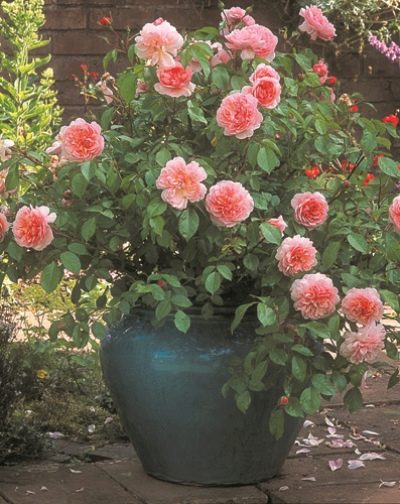
- Authors: Austin
- Name synonyms: Anne Boleyn
- Breeding year: 1999
- Group: English, bush
- The main color of the flower: pink
- Flower shape: rosette
- Flower size: large
- Diameter, cm: 7-9
- Flower type by number of petals: thick double
- Scent: fragrant
You can decorate a flower bed in the yard or in the country by planting beautiful and abundantly flowering pink varieties. Unpretentious in care, incredibly beautiful are the Anna Boleyn bush roses, which came to us from the UK.
Breeding history of the variety
The graceful flower Anna Boleyn is a creation of English breeders, which appeared in 1999. The author of the culture is the famous scientist David Austin. To breed the variety, the pink Graham Thomas was crossed with an unknown seedling. Roses are grown in different climatic zones of Russia.
Description of the variety
The English rose is a compact shrub that grows to a height of 90-100 cm. It is characterized by a pink spreading shrub with strong and flexible shoots, abundant branching, moderate thickening of medium-sized dark green leaves with a pronounced gloss, as well as a developed root system. The shrub width reaches 90 cm.
A distinctive feature is the absence of thorns on the shoots, which simplifies the process of leaving and pruning shrubs. On each stem, up to 8-10 delicate flowers are formed, collected in inflorescences.
Advantages and disadvantages
Rose Anna Boleyn is characterized by many advantages - frost resistance, good immunity that protects against fungal infections, abundant and long flowering, compactness of bushes, allowing planting in small flower beds or flowerpots. The disadvantages include the not very intense aroma of flowers, poor resistance to rain, as well as the fragility of blossoming roses.
Flowering features
The English pink variety belongs to the category of abundant flowering. The flowering period is quite long - from mid-June to the end of October. Due to the fact that roses bloom in waves, the bushes are practically never empty - some buds wither, while others bloom next.
Densely double rosette-shaped flowers have a dense structure consisting of 100-110 petals with wavy edges. The roses are quite voluminous and large - with a diameter of 7-9 cm. Not only the shape attracts attention, but also the very delicate color of the roses - from pale pink to bright pink on the back of the petals. The heterogeneity of the color looks very impressive. The blossoming flowers have a fragrant, fresh note, but a faint aroma.
Use in landscape design
The use of the pink variety is quite wide. Shrub roses are used both for single plantings and for group plantings. The flower is planted in mixborders, borders, ridges, flower beds, in front gardens. From the bushes, you can build a low flower fence, zone a flower bed, or plant it in a container, flowerpot.
Landing
Pink seedlings are planted in April-May, when a stable warmth has come. For cultivation, choose a bright and sunny place in the garden or in a flower bed, where there is no stagnation of cold air and moisture. It is not recommended to plant roses under tall trees and shrubs, as in constant shade the buds will become smaller and flowering will stop.
It is comfortable for bushes to grow in fertile, well-drained and breathable soils with low or neutral acidity. Before planting, the soil is enriched with organic and mineral components.
Growing and care
Healthy seedlings are planted in pre-prepared pits 40-50 cm deep, in which there is a drainage layer and a layer of fertilizers.After planting, abundant watering and compaction of the soil are required.
In care, the plant is absolutely unpretentious - enough watering with settled water, fertilizing, loosening, mulching and weeding, sanitary pruning of bushes, as well as preventive measures aimed at protecting against pests and fungal diseases. In addition, shrubs are sheltered for the winter.
Watering and feeding
Rose bushes are watered as the soil dries - one plant needs up to 10 liters of warm water. The plant does not tolerate excessive moisture. Complex fertilizers are applied every 2 weeks.
Pruning
Pruning is done to remove dry, damaged and frozen branches. In addition, it is necessary to carry out sanitary pruning, shorten shoots, and also pluck withered buds.
Frost resistance and preparation for winter
In regions with cold and little snowy winters, rose bushes are covered with burlap, agrofibre. When winter is warm enough good mulching, using spruce branches.
Diseases and pests
The culture has good immunity, providing medium resistance to powdery mildew and black spot. Pests (spider mites, sawflies and leafworms) attack pink plantings only in conditions of high dampness.































































